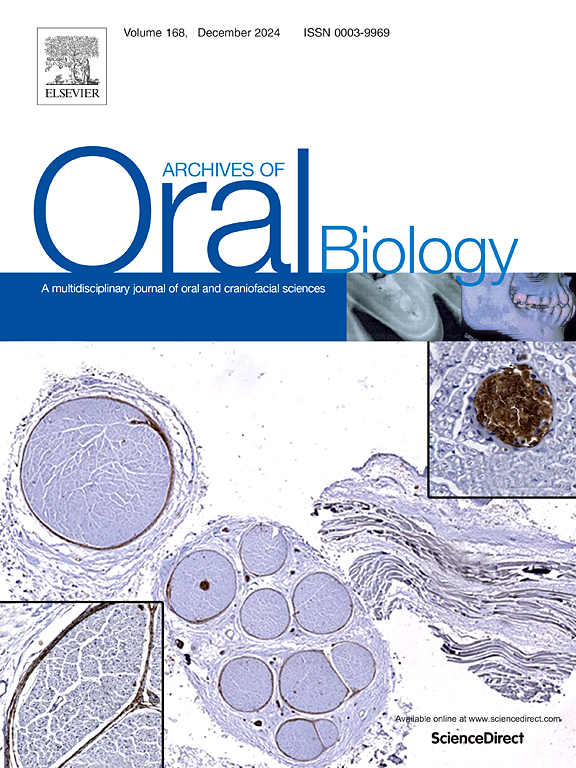乳牙牙釉质层叠的周期性。
IF 2.2
4区 医学
Q2 DENTISTRY, ORAL SURGERY & MEDICINE
引用次数: 0
摘要
目的:牙釉质层压是与瑞兹乌斯线平行或发育中的牙釉质表面紧密排列的增量线。本文计算了三个现代人群(新西兰、英国和加拿大)自然脱落的乳牙的牙釉质分层时间( = 111)。设计:采用标准组织学方法对牙齿进行切片,并用高倍显微镜检查。计算每颗磨牙牙尖区、侧区和颈区外牙釉质的平均日分泌率(DSR)。这些DSRs被用来确定每个区域的牙釉质生长的周期性。比较了不同种群、性别和臼齿内部的层压周期性,以评估层压周期性与层压与外表面夹角之间的关系。结果:57 %的磨牙存在层压( = 63 / = 111)。它们的存在在不同人群或性别之间没有变化。牙尖和外侧外牙釉质取样区平均为2天周期性。在颈外牙釉质中观察到平均一天的周期性。层压相对于牙釉质最外表面的角度与层压的存在有显著关系。结论:2天的分层周期表明,这种增量标记不是人类乳牙昼夜24小时节律的可靠代理。层纹的取向与瑞兹乌斯纹相似,但与交叉纹的取向不同。本文章由计算机程序翻译,如有差异,请以英文原文为准。
The periodicity of enamel laminations in human deciduous molars
Objective
Enamel laminations are closely spaced incremental lines that run parallel to Retzius lines or the developing enamel surface. Here, the timing of enamel laminations is calculated for naturally exfoliated deciduous molars (n = 111) from three modern-day populations (Aotearoa New Zealand, Britain and Canada).
Design
Teeth were sectioned using standard histological methods and examined using a high-powered microscope. Mean daily secretion rates (DSR) were calculated for the outer enamel of each molar in cuspal, lateral and cervical enamel regions. These DSRs were used to determine the periodicity of enamel growth across laminations in each region. Lamination periodicity was compared between populations and sexes, and within molars to assess the relationship between lamination periodicity and the angle between laminations and the outer surface.
Results
Laminations were present in 57 % of all molars (n = 63 out of n = 111). Their presence did not vary between populations or by sex. A mean two-day periodicity was observed in cuspal and lateral outer enamel sampling regions. A mean one-day periodicity was observed in the cervical outer enamel. The angle of laminations relative to the outermost surface of the enamel was significantly related to the presence of laminations.
Conclusions
A two-day periodicity for laminations indicates that this incremental marking is not a reliable proxy for a circadian 24-hour rhythm in human deciduous molars. The orientation of laminations was similar to Retzius lines but differed to the orientation of cross-striations.
求助全文
通过发布文献求助,成功后即可免费获取论文全文。
去求助
来源期刊

Archives of oral biology
医学-牙科与口腔外科
CiteScore
5.10
自引率
3.30%
发文量
177
审稿时长
26 days
期刊介绍:
Archives of Oral Biology is an international journal which aims to publish papers of the highest scientific quality in the oral and craniofacial sciences. The journal is particularly interested in research which advances knowledge in the mechanisms of craniofacial development and disease, including:
Cell and molecular biology
Molecular genetics
Immunology
Pathogenesis
Cellular microbiology
Embryology
Syndromology
Forensic dentistry
 求助内容:
求助内容: 应助结果提醒方式:
应助结果提醒方式:


